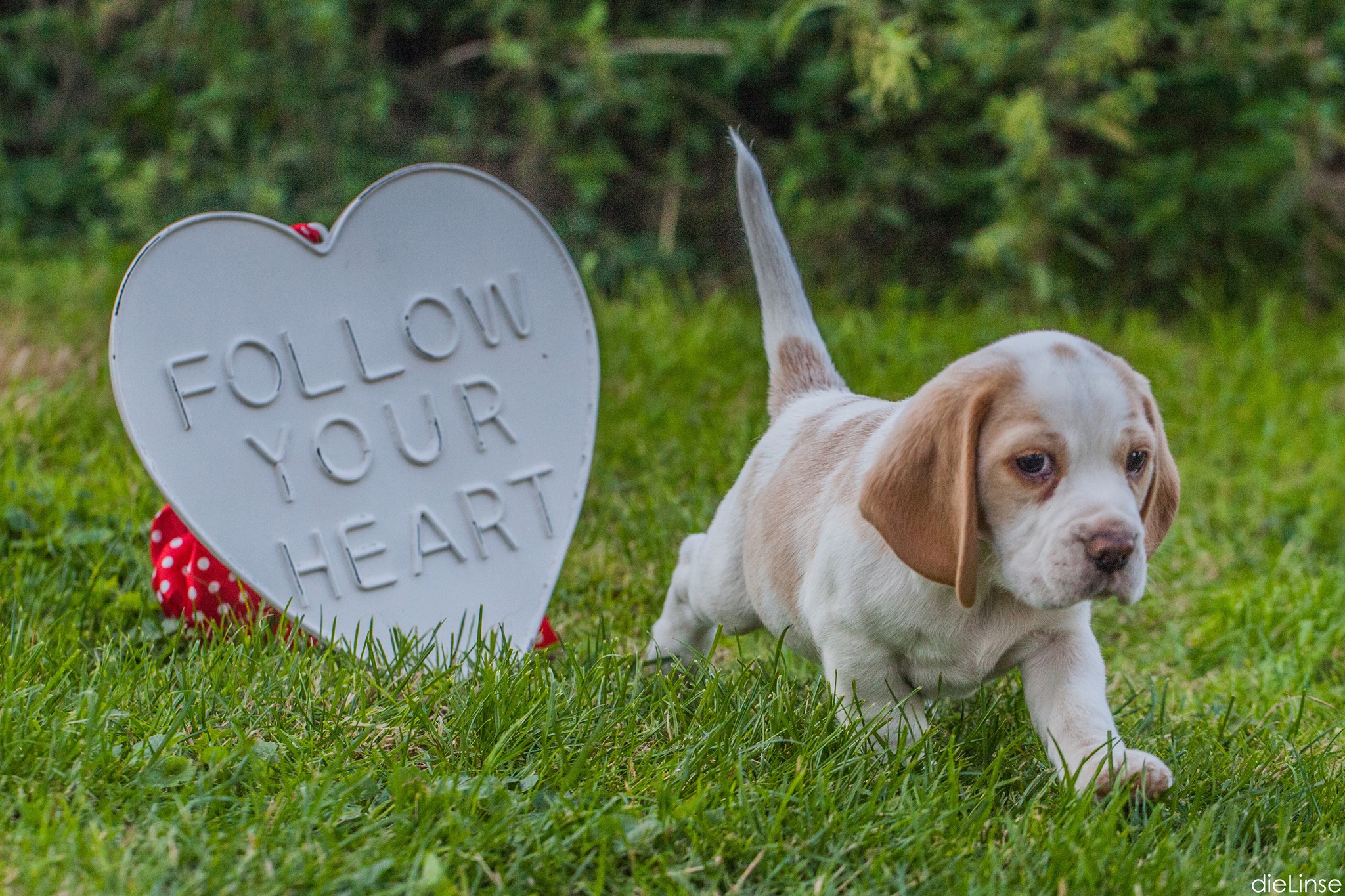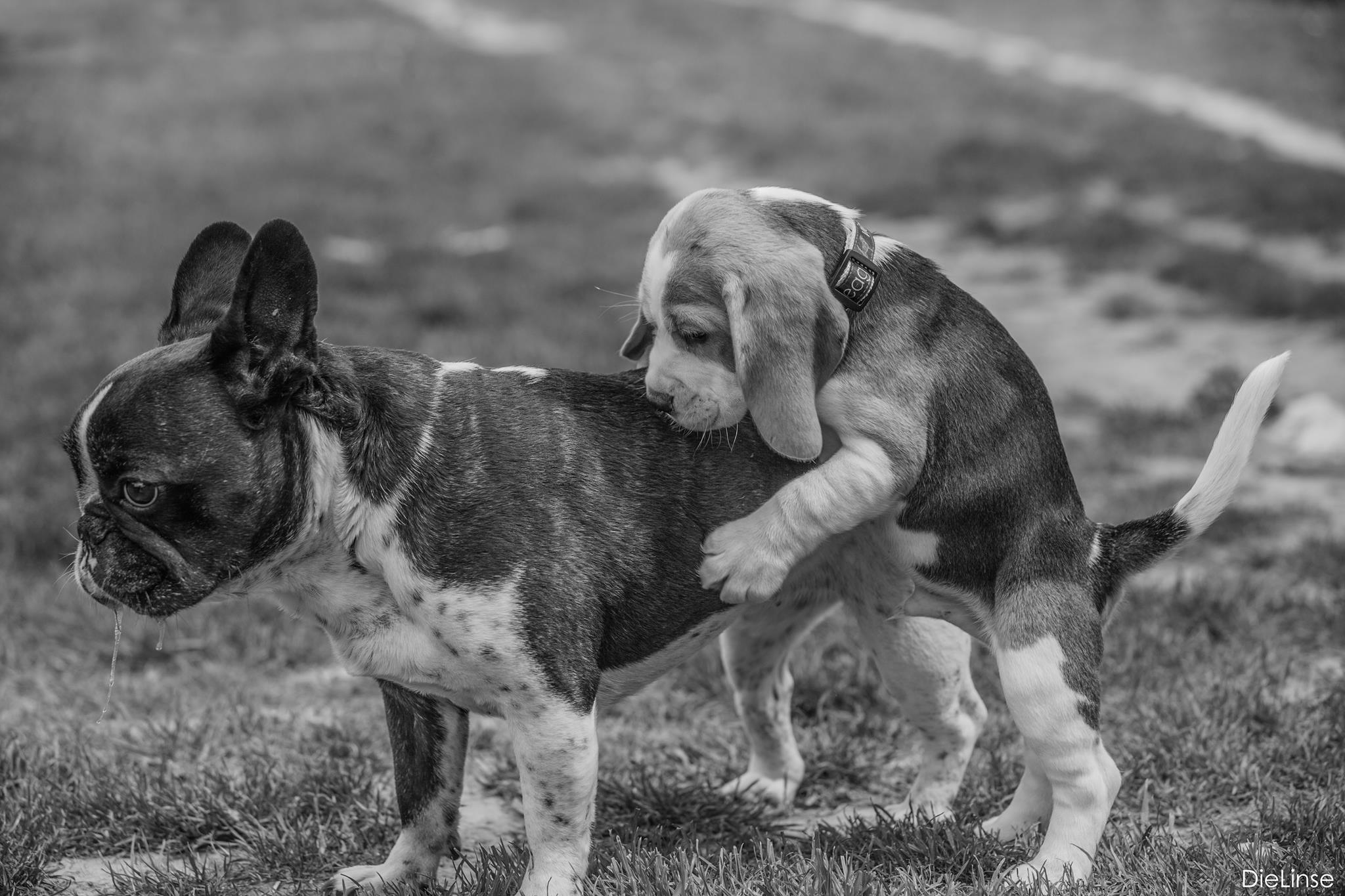Before we get a litter
As a prospective dog breeder, you have to acquire extensive knowledge. This includes in addition to any information and all the characteristics of the breed, anatomy of the dog, the diet specifically for bitches and puppies, diseases that often occur and knowlegde of heredity,
the breeding goals and of course the breeding regulations of the breed and much more. To be a dog breeder is a responsible task that you can't just do on the side. Either you should do breeding with all your heart or you shouldn't start at all. There are still a lot of investment in money and time is which is necessary to successfully breed dogs.
Requirements of a good breeding bitch
Getting to the point where you can pick up your puppy from us is a long process. This actually starts at least 2 years before a dog finally becomes a mother. Our bitches are either purchased or home-raised females. We started with our Dream back then - when she moved to us we admittedly didn't know much. Although she easily met all the requirements in terms of appearance, character and health, it didn't make it easy for us to get started. Dream gave us two litters and we had to learn the hard way that not everything is always like a textbook. The hereditary background of fertility, birth and motherhood should not be underestimated. Our second “basic dog” Masha then showed us that everything can be different. Since then both have been
crossed the Rainbow Bridge and their offspring marks our breeding activities to this day. A good breeding bitch is by no means just a “birthing machine” - in addition to the requirements of the breeding regulations, it is very important that an expectant mother dog has a balanced nature in everyday life. It is important that the dog is socially competent and instinctively confident. The influence of environmental conditions is not only formative in the first few weeks of the puppy, but also has an impact on the puppies while the bitch is still pregnant. For example, constant stress and results in stress hormone cortisol which has a gene-modifying potential. A bitch who cannot cope with a natural mating or who is stressed during a mating trip is just the tip of the iceberg - the epigenetic influence on the genes goes back so far that the bitch's experiences even before pregnancy are important. The environment is so important long before a dog becomes pregnant that it can have both positive and negative effects on the behavior of several generations of the offspring. A bitch's dispositions are of utmost importance for the relation between you and your puppy to get along well.
...who is the matching male?
It is said that you need two to tango. The importance of a stud dog for litter planning is therefore also great. The requirements for a stud dog are of course also set out in the breeding regulations of the Austrian Beagle Club or the breed clubs abroad. In addition, we choose male dogs that not only match the expectant mother in terms of pedigree, but also have just as much health and temperament as they do in appearance. It would be easiest to use our own male dogs every time - but would that still be considered breeding? Not from our perspective. We also think globally when planning a litter - even if your puppy will “just” become a family dog, we only make litters that we believe have significance for the breed in general. Every puppy that is born in our house should do the same have the potential to either stay with us for further breeding or be used elsewhere. For this reason, your puppy's father may live somewhere far away. We have already traveled from Italy to Denmark, from Germany to Hungary, from the Czech Republic to Poland and even Australia with the hope of using such male dogs in our breeding that are something special. A stud dog is in our imagination beautiful, healthy, stable representative of the breed and a dog that you would like to have with you in everyday life.
About the stud trip and mating
Being a breeder means having a lot of patience. Until a puppy leaves our houseour patience is often put to the test. And by that I don't mean the outrages that the little rascals commit until they're big enough to move out. We wait for a bitch to be ready for breeding - this happens around 2 years (the regulations say you can breed a bitch with us from 22 months, but our girls are usually a little older than 2 years when they have their first litter). During this time we wait for her to grow according to our expectations. We are waiting for the results of various exhibitions and health tests. We are waiting for the first heat so that the bitch can really grow up. Then we have to be patient and we wait for her to come into heat again around 24 months. Unless you can actually plan anything in terms of time. A male dog is selected, a B plan may also be made. We discuss the conditions with the stud dog owner (such as the stud fee, necessary preliminary examinations, a regulation in the event that the bitch does not have any puppies or few puppies, etc.).
Finally the time has come. The expectant mother is in heat - that means contacting the stud dog again quickly and possibly implementing a B plan. We have to make appointments with our vet for a bacterial test and mating time determination - and we have to wait again. On the right day. To determine the best time to breed, you not only take into account the behavior of the bitch and the interest of the male dog, but you also need a vaginocytology and possibly several progesterone tests. When the time finally comes, everything happens quickly - we leave everything behind and jump
into the car and are on the way to the selected male dog. Or we leave the female dog with our male dog. The behavior of the two is observed very closely and action is taken accordingly. Some don't want to be watched (understandable, right?), some do a lot of foreplay, but you have to make sure that the male dog doesn't get tired and that he doesn't lose interest. But one thing is always very important: that the two chosen partners like each other and that there is a natural mating. What exactly that looks is like a big play, ridden up a bit and described with the so-called “hanging” (standing bottom to bottom). In rare cases it is also possible to have a female dog artificially inseminated - in our opinion this is only necessary if the male dog lives extremely far away (as was the case with our E2 litter, where we had semen flown in from Australia ) or may already have died but there is frozen semen. Artificial insemination for these reasons can contribute a lot to our genetic pole and is associated with high costs. The prerequisite for any artificial insemination is that both expectant parents have produced puppies naturally at least once beforehand. We generally prefer two mating acts, although the repetition is only important for us humans - more mating acts do not produce more puppies. What is important is the right time, that the male dog has good semen quality and that the female dog has mature ovaries if the timing is right, the ovaries are fertilized. This means that there can be a larger litter in a single mating act. It is also possible that it will also be a success without “hanging”. If the timing is not right, the bitch can still be bred, it can happen even with several matings that she simply remains empty or there are fewer puppies. We send our breeding report to our club after successful mating. This is also generally the time when we contact the potential puppy families from our waiting list and post the upcoming litter on our homepage.
The waiting
Weeks pass again until we can be sure it worked. Of course, we are watching our hopefully expectant mother dog very closely: has her behavior changed? Has her ribcage become wider? Has she become (even) more greedy? Or does she not really like to eat? Is she pregnant or are we just telling ourselves? Or is she even just fake? The platonic question “do you think she is pregnant?” is probably heard several times a day in the house. To be really sure whether the dog is pregnant you can only determine with an ultrasound. Some vets and their equipment are good enough to start after just 3 weeks
Pregnancy can be determined by the date of the mating, but it is certain about 4 weeks. However, an ultrasound does not say how many puppies there will be. We can only determine whether there are really puppies growing in their tummies and whether there is just one or several. So an ultrasound is just to be sure it really has
succeeded. Usually, immediately after the ultrasound appointment, the phone rings for the stud dog owner and the future puppy owner and is followed by a cry of joy: “YES – she is pregnant!” The tummy becomes more visible day by day from the halfway point of pregnancy (58-63 days). In the last third, the bitch is switched to a more suitable type of food and gets more smaller meals per day. She is usually very active until the last 2 weeks - she may still play with the pack and like to go for walks. This activity decreases as she approaches birth. The whelping box is disinfected and set up. The mother is allowed to sleep in (or not) depending on her wishes. We are happy to receive visits from the puppy families until the last two weeks - so you can get to know the expectant mother better and be part of the expectation. As we all know, anticipation is the greatest joy. The last vet visit is made in the 9th and final week of pregnancy. At this point, the puppies are already more and more tactile and the tummy is literally moving. Since they are already well calcified we can have an X-ray done. This is harmless for the puppies and their
mother and in an x-ray we don't just see the number of puppies pretty accurate, but we can guess how far forward they have moved, are they rather big or small. From this moment on, our veterinarian will be available day and night. The tension increases with each passing day as we get closer to the date. Everything is checked – the whelping box is in place, vetbeds and sheets are washed. Everything you could possibly need during the birth is available - the list is long and it's getting longer! We learn something new with every birth and try to be even more prepared. We move entirely into the puppy room so that the expectant mother has peace and quiet and is always under supervision. The puppy families are also becoming impatient - messages are coming: “So what’s happening?” “How’s the mom?” “Is everything still calm?” It is not easy to remain patient and calm. We run crazy close to the mum when she tries to dig nests in the yard
and for every night out there is a flashlight and a cloth on hand just in case. The mother is not left out of sight. By the time we give birth we are already exhausted.
The birth and the first days
Describing a dog's birth is a very varied story, that would go beyond the scope here - we are of course happy to assist those interested in breeding with our specialist knowledge and support It all sounds so great and easy, but it's not. You would think that the more experience we have, the easier it would be. But it is exactly the opposite. The more knowledge we have, the more fears arise. We are usually at allert before the due date. And then the nerves get tense. Every bitch is different, every single puppy is different - and every birth is different. Therefore, keep calm it takes as long as it takes.
The puppies are finally here. At first there is a relief - everything is fine, they have landed. If no difficulties, even more beautiful. We record the birth weight and everything is cleaned up. The other pack members are allowed to sniff us out so that they notice - there are puppies in the house. From here it sometimes takes 1-3 days until we catch up on some sleep and clear our minds and every interested party will receive a call or message from us. You might think that everything is done now - but no, the administrative stuff also has to be done: first an unofficial report to our club about the arrival of the puppies, then the litter report follows with the names. As breeders, there are hardly any limits when it comes to choosing a name. We like “topics” that mean something to us and to the parents, about the eason or birth. But everyone can later name their own dog whatever they like - that is no longer our decision. Puppy packages are ordered and from this moment on the postman or the parcel delivery person often rings. It is also important to have everything ready for moving out from this point onwards...
The first two weeks after birth seem to be unspectacular at first. The puppies are watched over around the clock - everything is changed and washed several times a day. The weights are checked at least once. If someone isn't gaining weight so well or seems weaker, help will be given. The puppies' main activity is drinking and sleeping - this is the so-called "vegetative phase". At this time
the puppies are completely dependent on the mother. They need her milk, her warmth and her cleaning. A busy time now begins for the mom. The newborn puppies already have thick, short fur, relatively short legs and an almost oversized mouth. The newborns act
purely from their instinct - their eyes and ears are still tightly closed, their sense of smell is not very developed. After birth, they have a good sense of touch and a strong sense of warmth. After birth, the puppies are unable to regulate their body temperature completely independently. Their body temperature at this point is around 35-36 °C. They move by pendulum movements and this is how they find their way to the teat, where they drink until they are full. If you have several puppies, a certain amount of control is important - all puppies should be fed and the larger ones should not push the smaller ones away. It is also important that the temperature is right - the puppies can only digest with enough heat. They should be warm, well hydrated
and be actively mobile. They then sleep until the next meal. The mother takes on the other part: she massages the puppy's stomach with her tongue to stimulate urination and defecation. She cleans the whelping box and checks the umbilical cord. We are
excited and fascinated every time by their rapid development. This enthusiasm doesn't diminish even after many litters - we sit next to the whelping box for hours, watching over the mother and her puppies day and night. In these early days it is important that the bitch and puppies have peace and quiet, strangers visitors should be an exception. The mother can devote herself intensively to her litter, the puppies are calm and relaxed and spend their time drinking and sleeping. It is fascinating to observe how routinely and lovingly dogs look after their puppies. You can only judge the dog's enormous work performance if you yourself
once raised a motherless litter, feeding every 2 hours, belly massage, about 15 minutes per dog, keeping warm, etc. everything has to be organized. If you think about it, you realize how much has already happened in these unspectacular weeks.
If we move away from the puppies a puppy camera will ensure that we always keep an eye on the whelping box. Generally one of us is always on “puppy duty”.
It is very important to weigh the puppies. A weight lossis actually normal and not very worrying in the first two days - the puppy must first adapt to the new diet. The weight should then increase continuously and the puppies will double their birth weight after about a week. In the second week, the bitch's bed bond loosens. She is again interested in shorter walks and lies down with the pack members. She can of course move freely and has access to her puppies at all times. At the slightest whimper, the mother is there, nursing, cleaning and cuddling the little ones extensively. The other dogs are greeted happily, but pushed away in a friendly and determined manner to prevent access to the room with the puppies. The mother can decide for herself at any time when the other dogs are allowed to visit the puppies. Some are impatiently waiting to have more contact with the puppies, and some, especially the older ones and our male dogs, prefer to keep their distance and not let puppies in the house disturb their peace and quiet.
Foreign visitors are not permitted for the first 3 weeks. The dog family should rest.The future puppy owners are regularly informed about the progress with pictures and reports.


